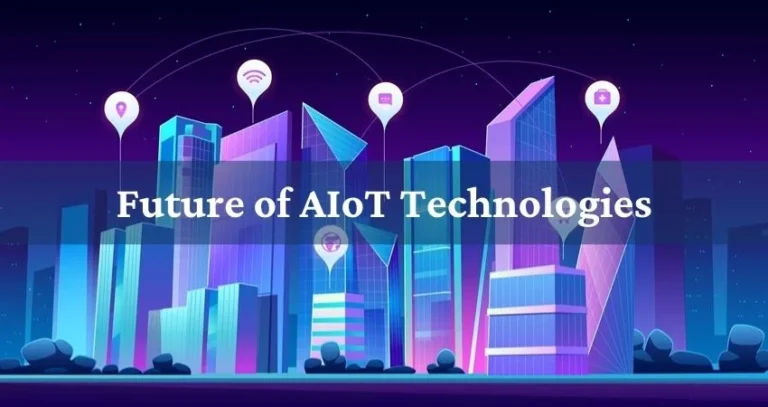The incorporation of Artificial Intelligence (AI) into the Internet of Things (IoT) is gaining momentum across various sectors. This synergy is a central element in what is known as the “Fourth Industrial Revolution,” commonly referenced as “Industry 4.0.”
The focus of this revolution is on integrating information technology systems, human expertise, and digital production machinery to greatly improve operational efficiency – all of it fueled by large amounts of data.
While IoT and AI individually offer their own benefits, their fusion into AIoT represents a transformative leap, unlocking their full potential and opening new avenues for innovation.
Understanding the Concept of AIoT
AIoT marks a significant stride in industrial evolution. IoT devices, already a staple in various sectors, enable seamless data communication, storage, and exchange over the Internet. They’re now generating an extraordinary amount of data, with in-service IoT devices expected to reach over 42 billion globally by 2025.
The challenge, however, lies in transforming the information collected into actionable insights. That’s where AI steps in. AI excels in analyzing and interpreting data far more effectively than human capabilities, leading to quicker and more informed decision-making.
AIoT is built on three foundational technologies:
- AI: It provides advanced functions and systems for learning, reasoning, and processing, simulating human cognitive abilities.
- 5G networks: These ensure high-speed, low-latency communication, vital for real-time data handling.
- Big Data: It enables the accumulation of extensive data sets from various interconnected sources.
The synergy of these technologies holds the potential to dramatically alter how both individuals and businesses interact with their environments.
What are the Core Capabilities of AIoT?
AIoT is built on five principal functionalities:
- Scalable data storage solutions.
- Centralized collection of telemetry data from devices and sensors.
- Data set processing and analysis.
- Optimal device management
- Data-driven decision making
In the AIoT framework, AI acts as the central intelligence, analyzing patterns in telemetry data and allowing for autonomous decision-making, bypassing the slower process of human analysis.
AI actually improves IoT devices with smarter capabilities, enabling them to process data both at the source and destination quickly and in real-time. For example, cameras equipped with image sensors would traditionally transmit an entire video feed for human analysis. However, with AI integration, the camera would only send specific relevant frames, significantly reducing delay and data congestion.
AI’s capabilities are further improved by neural networks and deep-learning models, which respond in real-time to critical conditions, potentially preventing severe outcomes. In a manufacturing setting, for example, AIoT could detect critical system flaws that might lead to accidents or injuries. Rather than relaying this information to a human operator, AI could directly shut down the system to avert a disaster.
How is AIoT Being Used in Industries Today?
AIoT has already made its mark in various industries, from healthcare and agriculture to manufacturing and transportation. Here are some examples of how AIoT is being used today:
Health Tech Wearables
In consumer spaces, the Internet of Things (IoT) is prominently featured in health-related wearables. Fitness trackers and smartwatches that utilize IoT to observe and record user behaviors, routines, and preferences are becoming increasingly popular.
In the medical field, the application of wearable technologies extends even further. Beyond basic fitness tracking for everyday users, these devices are also crucial for healthcare professionals in monitoring patients requiring more comprehensive care. This is particularly relevant for individuals with chronic conditions such as heart disease or diabetes. Health tech wearables enable doctors to continuously track their patient’s health through detailed data, reducing the need for frequent physical consultations.
Intelligent Homes
Smart homes are a perfect representation of how powerful IoT can be. Common smart home devices include intelligent thermostats, lighting systems, televisions, and appliances like refrigerators. These gadgets gather user data to continually enhance the user experience. For example, a smart refrigerator might help manage grocery lists, or a smart thermostat could adjust room temperatures based on previous usage patterns.
Smart home technologies also improve quality of life and energy efficiency in several ways. For example, intelligent lighting systems can align with an individual’s sleep patterns to promote better rest, while smart thermostats may automatically adjust to facilitate deeper sleep.
Smarter Cities
Like smart homes, smart cities operate on a grander scale, providing solutions to infrastructure challenges in fast-growing urban areas. These cities often deal with challenges such as overcrowding, safety concerns, deteriorating air quality, and efficient resource management. Meanwhile, urban planners are also tasked with optimizing transportation and energy consumption despite growing populations.
AIoT emerges as a key player in enhancing the functionality of these cities. It offers innovative solutions that not only streamline city operations but also tackle critical issues related to the environment and public health, making urban living more sustainable and efficient.
AIoT can also monitor and adjust traffic flow to alleviate congestion and lower accident risks. When it comes to housing, smart buildings are designed to support large populations efficiently, using intelligent thermostats and lighting systems to save energy while maintaining comfort.
Better Surveillance Systems
AI and IoT technologies are revolutionizing the field of video surveillance and security. Traditional surveillance systems often experience challenges when capturing all suspicious activities taking place due to limited visibility and variable reaction times.
AIoT integrates machine learning with camera feeds to analyze visual data in real time. This advanced approach enables the automatic detection of objects and face recognition technology, offering a much more responsive and efficient security framework.
AIoT also plays a pivotal role in certain security applications like weapon detection or intrusion alerts. Here, deep learning models contribute to improved safety using virtual fence markers. These markers monitor the movements of individuals and detect any unauthorized access, preventing possible security breaches from taking place.
Embracing the Promising Future of AIoT
AIoT is progressively becoming a central part of our everyday lives, creating a future that is safer, more efficient, and increasingly interconnected. This evolution marks a significant step towards enhancing operational efficiency and decision-making across diverse industry sectors.

Author Bio:
Guido Voigt
Guido Voigt is the Director of Engineering, at Lantronix, a global provider of turnkey solutions and engineering services for the internet of things (IoT). Guido’s and Lantronix’s goal is to enable their customers to provide intelligent, reliable, and secure IoT and OOBM solutions while accelerating time to market.


